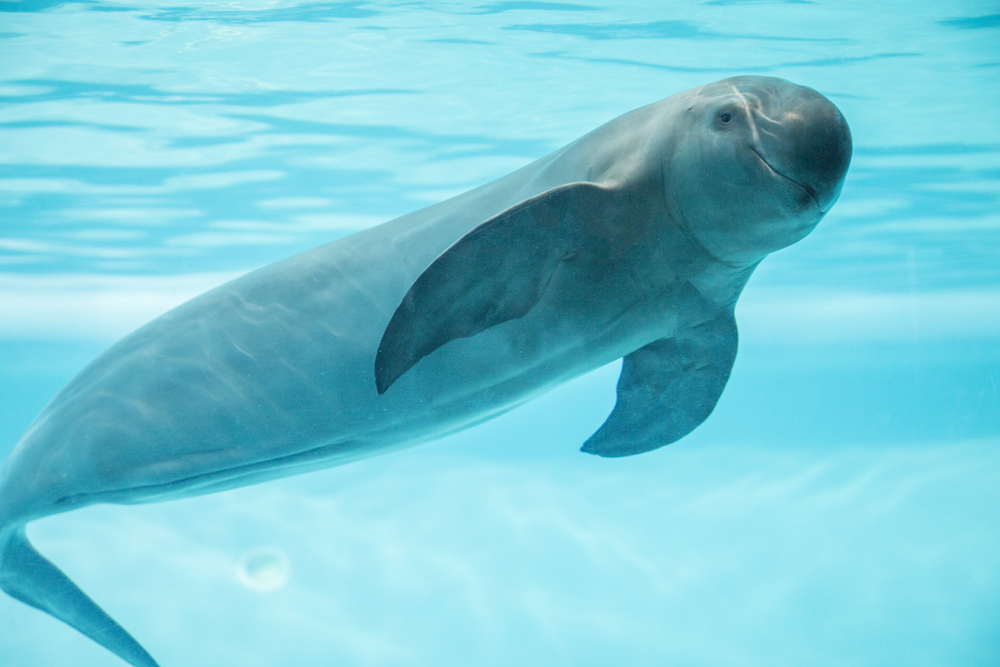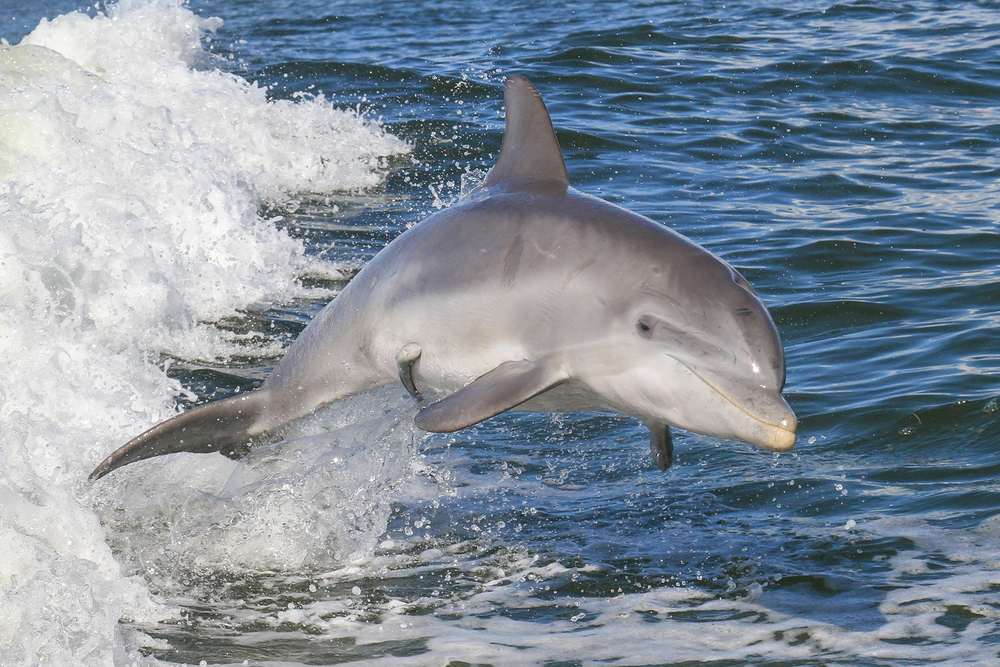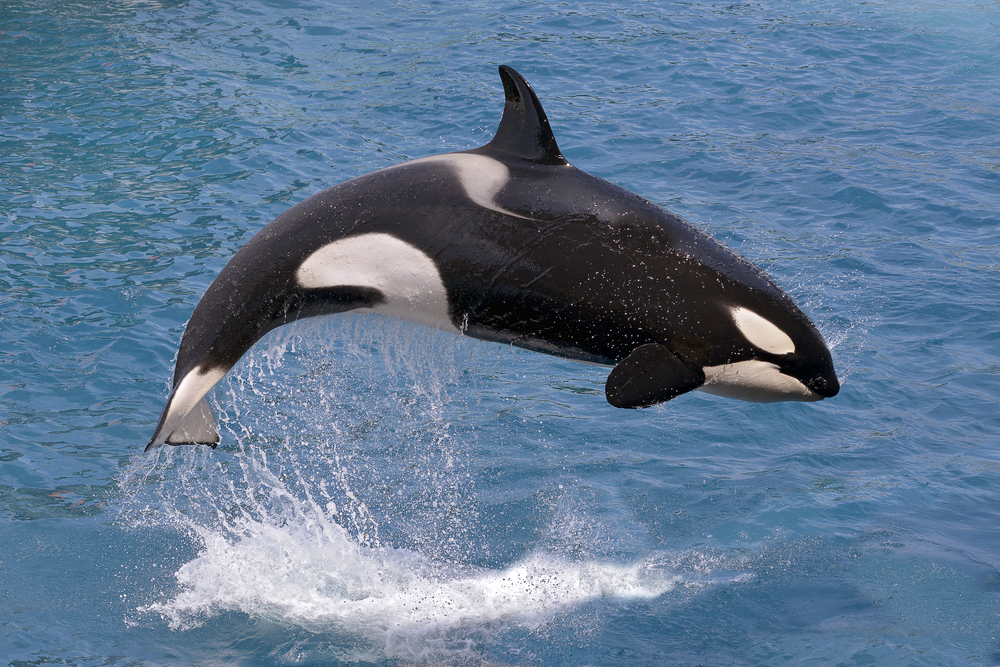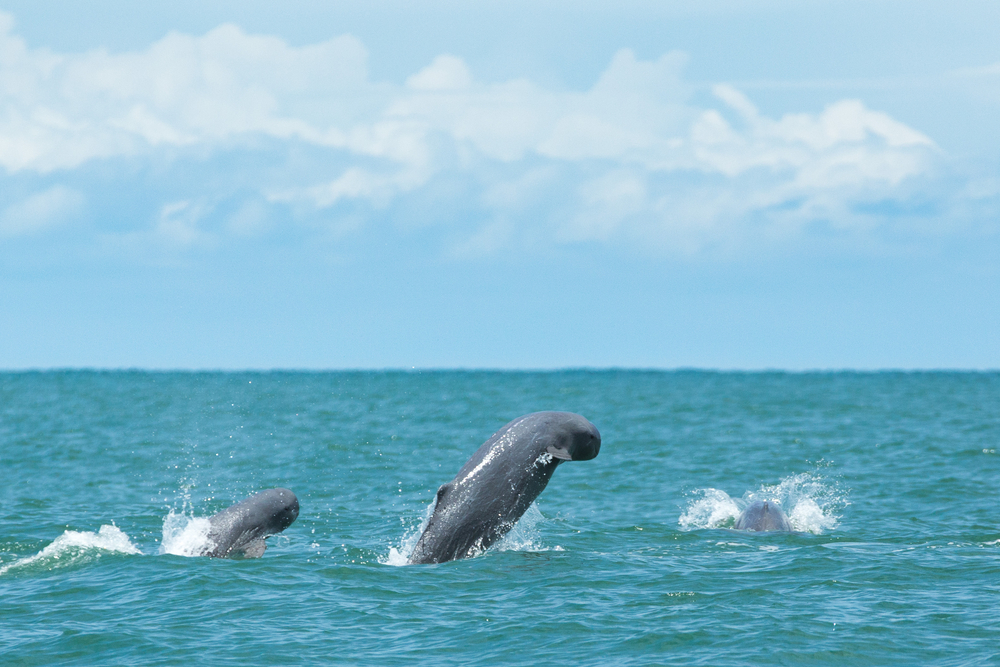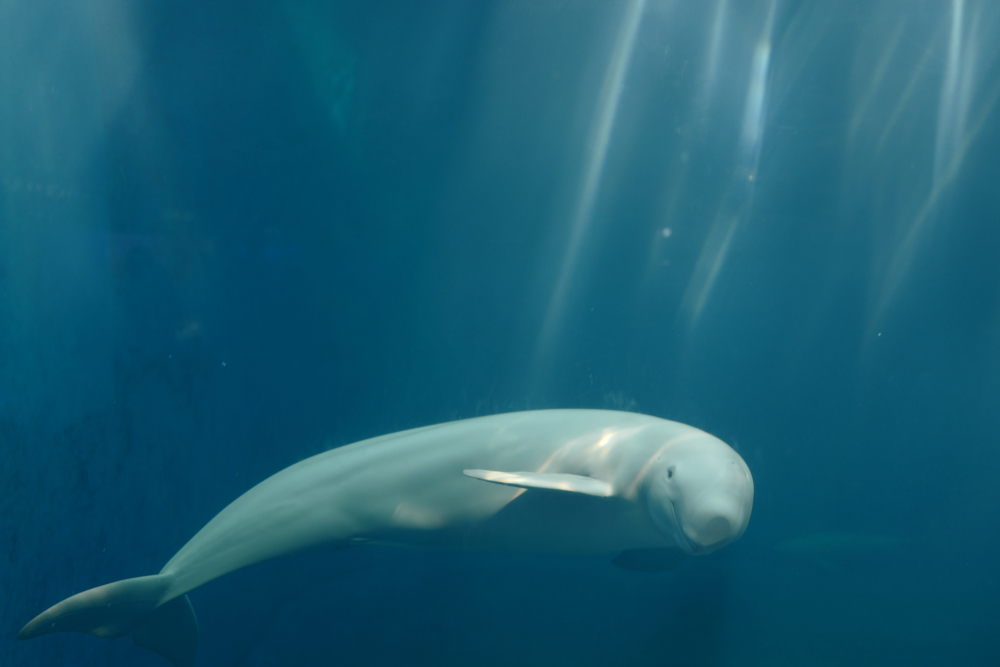About
The Finless Porpoise, scientifically known as Neophocaena phocaenoides, is a species of small cetacean within the Animal Kingdom’s class Mammalia and order Cetacea. It belongs to the Phocoenidae family, which also includes other porpoise species such as the harbor porpoise. Finless Porpoises are found in coastal waters and estuaries throughout the Indo-Pacific region, including the waters of East Asia and Southeast Asia.
These porpoises are easily distinguished by their lack of a dorsal fin, giving them a sleek and streamlined appearance. They have a rounded head with a small, triangular dorsal ridge instead of a prominent dorsal fin. Finless Porpoises typically measure between 1.5 to 2 meters in length and weigh around 60 to 80 kilograms, making them one of the smallest cetacean species.
Finless Porpoises are highly adapted to their coastal habitats, where they feed on a variety of fish, squid, and crustaceans. They use echolocation to navigate and locate prey in murky waters, emitting high-frequency clicks that bounce off objects and return to the porpoise, providing information about their surroundings.
Despite their widespread distribution, Finless Porpoises face significant conservation concerns, primarily due to habitat loss, pollution, and entanglement in fishing gear. Human activities such as coastal development, pollution from industrial and agricultural runoff, and overfishing have degraded their habitats and reduced prey availability.
Additionally, Finless Porpoises are susceptible to accidental capture in fishing gear, such as gillnets and trawls, which can lead to injury or death. As a result, their populations are declining in many areas, with some local populations facing the risk of extinction.
Conservation Concerns
The International Union for Conservation of Nature (IUCN) Red List classifies the Finless Porpoise as vulnerable to extinction, highlighting the urgent need for conservation action to protect their populations. Conservation efforts include habitat conservation, the establishment of protected areas, regulation of fishing practices, and public education and awareness campaigns about the importance of preserving coastal ecosystems and reducing human impacts on marine wildlife.
Continued research, monitoring, and international cooperation are essential for implementing effective conservation strategies to ensure the long-term survival of the Finless Porpoise and other marine mammal species.
Physical Characteristics
The Finless Porpoise (Neophocaena phocaenoides) is a unique and intriguing marine mammal found in the coastal waters and rivers of Asia, from the Persian Gulf to Japan. As its name suggests, this species is distinguished by the absence of a dorsal fin, a feature that sets it apart from most other cetaceans. The finless porpoise is one of the smallest porpoise species, exhibiting several adaptations that enable it to thrive in its specific aquatic environments.
Size and Weight:
- Length: Adult finless porpoises typically measure between 4.9 to 6.2 feet (1.5 to 1.9 meters) in length.
- Weight: They weigh around 66 to 121 pounds (30 to 55 kilograms), with some variation depending on their specific habitat and population.
Physical Characteristics:
- Dorsal Ridge: Instead of a dorsal fin, finless porpoises have a unique feature: a dorsal ridge that starts from the mid-back and runs towards the tail. This ridge is covered in small tubercles or bumps, which may enhance hydrodynamics or play a role in sensory perception.
- Body Shape: They have a robust, streamlined body that tapers to a narrow tail, designed for efficient swimming in both coastal and freshwater environments. Their body is more flexible in the middle, allowing them to make sharp turns to catch prey.
- Skin Color: The skin color of finless porpoises ranges from a dark grey to a light greyish-pink, with a lighter underside. This coloration provides camouflage in their often murky aquatic habitats.
- Head and Face: They have a rounded head with a flat, indistinct beak. The forehead is bulbous, and the mouth is equipped with small, spade-shaped teeth ideal for grasping slippery prey.
- Flippers and Tail: The pectoral flippers are small and rounded, helping in maneuvering through water. The tail flukes are broad and provide powerful propulsion.
- Breathing and Vocalizations: Finless porpoises have a small blowhole located on the top of their head, slightly to the left side. They are less vocal compared to other cetaceans, but they do produce a variety of clicks and whistles, likely used for navigation (echolocation) and communication within their groups.
- Behavior: Finless porpoises are often shy and elusive, making them difficult to observe in the wild. They are known to live in small groups and have a preference for shallow waters close to shore, as well as estuaries and rivers.
The Finless Porpoise’s distinct lack of a dorsal fin and its unique adaptations for life in coastal and riverine environments highlight the diversity of marine mammal evolution. Their presence in the waters of Asia underscores the importance of these habitats for biodiversity, while also drawing attention to the conservation challenges faced by species living in close proximity to human activitiess.
Reproduction
The reproductive cycle of the finless porpoise is influenced by various environmental factors and social behaviors. Here’s an overview:
Breeding Season: Finless porpoises do not have a strict breeding season, and mating can occur throughout the year. However, peaks in mating activity have been observed in some regions, often coinciding with periods of higher water temperatures and food availability.
Courtship and Mating: Male finless porpoises, known as bulls, engage in courtship behaviors to attract females, including chasing, vocalizations, and physical displays. Once a male successfully courts a female, mating occurs underwater.
Gestation: The gestation period for finless porpoises typically lasts around 10 to 11 months, similar to other cetaceans.
Nesting and Birth: Finless porpoises give birth to a single calf, although rare cases of twins have been reported. Calves are usually born tail-first to prevent drowning during birth. Mothers provide extensive care to their newborn calves, helping them to the surface for their first breath and guiding them in their early movements.
Maternal Care: Female finless porpoises are highly attentive mothers, nurturing and protecting their calves in the early stages of life. They nurse their young with nutrient-rich milk, helping them grow and develop.
Weaning and Independence: Calves are weaned gradually over several months, transitioning from milk to solid food. During this time, they learn essential survival skills from their mother, including hunting techniques and social behaviors.
Sexual Maturity: Finless porpoises reach sexual maturity at different ages depending on factors such as gender and environmental conditions. Females typically reach maturity between 4 to 7 years old, while males may mature slightly later, around 5 to 9 years old.
Social Interactions: Finless porpoises are social animals, often found in small groups or pods. These pods may consist of individuals of varying ages and genders and play a crucial role in their reproductive behaviors and social dynamics.
Conservation Concerns: Finless porpoises face various threats to their survival, including habitat degradation, pollution, bycatch in fishing gear, and disturbance from human activities. Conservation efforts aim to mitigate these threats and protect the species’ habitat to ensure their long-term viability.
Lifespan
The finless porpoise, characterized by its lack of a dorsal fin, is a small cetacean species found in coastal waters and rivers across Asia. Here’s an overview of their lifespan and threats to their life:
Lifespan in the Wild: In their natural habitat, finless porpoises have a relatively long lifespan compared to other cetacean species. They can live up to 20 to 30 years, depending on factors such as environmental conditions, predation, and human impacts.
Lifespan in Captivity: In captivity, finless porpoises may have a shorter lifespan compared to their wild counterparts. While specific data on the lifespan of captive finless porpoises are limited, factors such as stress, inadequate diet, and lack of social interactions can contribute to reduced longevity.
Threats to Finless Porpoises:
- Habitat Loss and Degradation: Habitat loss due to coastal development, pollution, and habitat degradation from human activities such as dredging and fishing pose significant threats to finless porpoises. Destruction of their habitat limits their access to food, breeding grounds, and safe resting areas.
- Fisheries Bycatch: Finless porpoises often become unintentional victims of fisheries bycatch, where they become entangled in fishing gear such as gillnets and trawls. Bycatch mortality is a significant threat to porpoise populations, leading to injuries, suffocation, and death.
- Pollution: Pollution from industrial and agricultural runoff, as well as marine debris, contaminates the water and affects the health of finless porpoises. Chemical pollutants, plastics, and heavy metals can bioaccumulate in their bodies, leading to reproductive issues, weakened immune systems, and overall health decline.
- Noise Pollution: Underwater noise pollution from shipping, construction, and other human activities interferes with the acoustic communication and echolocation abilities of finless porpoises. Prolonged exposure to high levels of noise can cause stress, disrupt foraging behavior, and increase the risk of collisions with vessels.
- Climate Change: Climate change-related impacts, such as sea-level rise, ocean acidification, and changes in water temperature and currents, can alter finless porpoise habitats and prey availability. These changes can have cascading effects on their food web and ultimately impact their survival and reproduction.
Conservation efforts for finless porpoises focus on habitat protection, reducing fisheries bycatch, mitigating pollution, and addressing climate change impacts. Collaborative initiatives involving governments, researchers, conservation organizations, and local communities are crucial for the long-term conservation of this vulnerable species.
Eating Habits
The finless porpoise is a small cetacean found in coastal and freshwater habitats throughout Asia. Understanding its eating habits provides insight into its ecological role and adaptations for foraging in diverse aquatic environments.
Diet: Finless porpoises are primarily piscivorous, meaning they primarily consume fish. Their diet consists of a variety of fish species, including but not limited to:
- Small Fish: Finless porpoises prey on small fish species that inhabit coastal waters and river systems. Common prey items include anchovies, herring, mullet, and gobies.
- Crustaceans: In addition to fish, finless porpoises may also consume crustaceans such as shrimp and crabs, particularly in estuarine and riverine environments where these prey items are abundant.
Foraging Behavior: Finless porpoises employ several foraging strategies to capture their prey:
- Echolocation: Like other toothed cetaceans, finless porpoises use echolocation to detect and locate prey in their aquatic environment. They emit high-frequency clicks and listen for the echoes bouncing off nearby objects, including potential prey items.
- Suction Feeding: Finless porpoises utilize suction feeding to capture small fish and crustaceans. They generate negative pressure within their mouth by rapidly expanding their pharyngeal cavity, creating a suction force that draws prey into their mouth.
Prey Preferences: While finless porpoises primarily feed on fish, their prey preferences may vary based on factors such as local prey availability, habitat characteristics, and seasonal fluctuations in prey abundance. They may opportunistically target different fish and crustacean species based on their nutritional needs and prey availability.
Other Considerations:
- Finless porpoises are highly adapted to their aquatic environment, with streamlined bodies and specialized sensory adaptations for efficient swimming and prey detection.
- Human activities such as overfishing, habitat degradation, and pollution pose significant threats to the finless porpoise population by reducing prey availability and degrading their aquatic habitat.
- Conservation efforts aimed at protecting finless porpoises and their habitats are crucial for ensuring their long-term survival and maintaining healthy aquatic ecosystems.
Uniqueness
The Finless Porpoise, scientifically known as Neophocaena phocaenoides, is a distinctive species of porpoise that stands out due to several unique features and adaptations. Here are some key aspects that make the Finless Porpoise unique:
Lack of Dorsal Fin: True to its name, the Finless Porpoise is notable for its complete lack of a dorsal fin, which is uncommon among cetaceans. Instead, it has a smooth, rounded back with a series of bumps or ridges running down the midline, starting from about the midpoint of the back towards the tail. This adaptation may help with maneuverability and camouflage in shallow, murky waters where they often reside.
Habitat and Range: This species is found primarily in the coastal waters and rivers of the Indo-Pacific, ranging from the Persian Gulf east to Japan, and south to Indonesia. They are one of the few cetaceans adapted to both saltwater and freshwater environments, capable of living in rivers as well as coastal areas.
Small Size and Body Shape: Finless Porpoises are relatively small compared to other cetaceans, reaching about 1.5 to 2 meters in length. They have a sleek, streamlined body that aids in navigating through their often complex and shallow aquatic habitats.
Behavior and Social Structure: Typically shy and elusive, Finless Porpoises are less social than many other dolphin and porpoise species. They are usually seen alone or in small groups of two to three individuals. Their shy nature and subtle surfacing behavior, with little splashing and no leaping, make them less noticeable in their natural environment.
Echolocation Abilities: Like other cetaceans, Finless Porpoises rely heavily on echolocation to communicate, navigate, and locate prey in turbid river waters where visibility is low. They emit high-frequency clicks that help them map their surroundings.
Diet: Their diet mainly consists of fish and shrimp. They use their well-developed echolocation to detect and hunt small prey in the muddy bottoms of rivers and coastal areas.
Conservation Status: The Finless Porpoise is classified as vulnerable, facing threats from habitat loss, water pollution, accidental capture in fishing nets, and the impacts of river traffic. Their dependence on riverine and coastal habitats makes them particularly susceptible to human activities.
Reproductive Habits: Finless Porpoises have a low reproductive rate, which complicates efforts for population recovery. Females typically give birth to one calf every two years, following a gestation period of about 10 to 11 months.
The unique physical and behavioral traits of the Finless Porpoise, such as the absence of a dorsal fin, adaptation to both freshwater and marine environments, and discreet behavior, make it a particularly interesting subject of study in marine biology. Protecting this vulnerable species is crucial for maintaining the biodiversity of the regions they inhabit.






























































